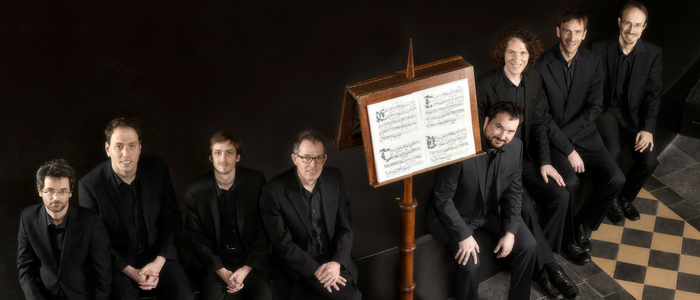Side Notes: Stratton Bull, singer and Artistic Director of Cappella Pratensis

Photo by Hans Morren
Artists lead complicated lives. They collect material for new work, they often teach and engage with community groups and they are always developing their craft.
In Side Notes, we are providing good reads and fun facts to give you a sense of who our visiting artists are and what makes them do what they do. Contributing writes include students, faculty, staff and alumni from the extended Clarice family.
We were given the chance to hear from Stratton Bull, singer and Artistic Director of Cappella Pratensis, who shared a few insights about performing with the ensemble:
As an ensemble, you often perform from original facsimiles on a single music stand. How do these choices change the overall performance, and what are some difficulties you encounter?
This way of performing is a real game-changer. The music itself is notated in separate parts so that the singers are obliged to use their ears to contact the other parts – no visual cues. This creates a very physical connection between the singers. There are no barlines, which increases the sense of flow. The presentation of the notes is also very compact, so that the shapes of the melodies are very clear, and also often made with beautiful and inspiring calligraphy. The clarity of flowing, individual melodies working in concert is the essence of polyphony. The main “difficulty” is, of course, that modern singers are not trained in singing from this old “mensural” notation, so there’s always a strong learning aspect required (and finding last-minute replacements is a pain...).
The fact of sharing one large book on a music stand also creates a closer physical connection between the singers. When everything is clicking, this creates the effect of many voices coming out of one entity. This feature is also a challenge, however, since the proximity of the voices can cause interference between them as well. It is thus important to keep the lines clear and balanced.
The ensemble has performed all around the world in some remarkable locations. What are some unforgettable performances?
Most recently we performed in the National Gallery in Washington, a very special opportunity for us. Also this year we sang for the first time in Venice at the famous San Rocco church, surrounded by paintings by Tintoretto. And one of my earliest memories with the group was touring in Japan, where the serenity and fine detail of this music seemed to accord with the Japanese aesthetic: seldom have we had such intensely concentrated audiences.
Favorite Renaissance composer(s) to perform?
Difficult to know where to start! One of the great things about this repertoire is how many fantastic composers there are in the 15th and 16th centuries... As our “patron saint,” Josquin Desprez has to be at the top of the list. There is something deeply satisfying about his music. Another special favorite is Pierre de la Rue, court composer to the Habsburg-Burgundians: always elegant and graceful, but also playful and often deeply moving. And Heinrich Isaac, whose music we’ll perform in the present concert, is a brilliant dramatist who deserves much more airplay!
How much do you consider yourselves to be scholars of this music, as well as musicians?
I’d say there is a range within the group. Two of the singers in the group are full-fledged musicologists; others (like myself) are attuned to the scholarly world, without actually being active contributors. And others would probably describe themselves as singers in the first place, drawn to this approach to music making without being involved in the musicological side.
How do you see the music that you perform retaining relevance for us today?
My first answer would be: it’s amazing music, that makes it relevant today or anytime! But more specifically, I’d say the whole notion of “polyphony” is very much alive at the moment: the postmodern age is all about allowing many different voices to sound together. Polyphony as a metaphor turns up all over the place these days, so hearing the real thing is a way to experience this concept first-hand. And of course, there is the “chill factor” of this music, which is often about serenity and slowing down to absorb detail and emotion. That's something we could use a little more of at the moment.
What’s the story behind the name of the ensemble?
“Pratensis” is Latin for “of the fields” or in French “des près,” so it's a way of acknowledging – and invoking! – one of the great composers of the Renaissance, Josquin Desprez.
Side Notes compiled by Rachel Ruisard, a University of Maryland PhD student.
